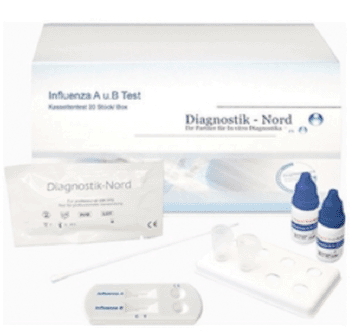Use of a Rapid Test to Diagnose Influenza in the Emergency Room Influences Choice of Treatment
By LabMedica International staff writers
Posted on 26 Nov 2013
An exhaustive retrospective study conducted in the United States found that patients tested for and diagnosed with influenza with a rapid test were more likely to receive appropriate treatment than those diagnosed with the flu without testing.Posted on 26 Nov 2013
Investigators at the University of Utah (Salt Lake City, USA) reviewed data from the National Hospital Ambulatory Medical Care Survey, a nationally representative sample of emergency room visits in the US From this database they identified children and adults who had been diagnosed with influenza across three flu seasons (2007-2009).

Image: A rapid “lateral flow” test for influenza A and B (Photo courtesy of Praxisdienst).
Analysis of the data showed that 23% of patients diagnosed with influenza without rapid testing received a prescription for antibiotics, which are not effective in treating influenza. However, only 11% patients who were diagnosed by rapid testing were given prescriptions for antibiotics. Additional laboratory tests, including chest X-rays, blood tests, and urinalysis were ordered less frequently for patients whose influenza illness was diagnosed with a rapid test.
Prescriptions for antiviral drugs, which can be effective in treating influenza when used early and appropriately, were ordered for 56% of patients diagnosed with influenza using a rapid test, compared to orders for prescriptions for antiviral drugs for only 19% of influenza patients diagnosed without testing.
Overall, the data showed that influenza diagnoses made in association with a rapid assay resulted in fewer additional tests, antibiotic prescriptions, and more frequent use of antiviral drugs. These findings suggest that results of rapid testing influence physician behavior.
"When results of influenza tests are available to physicians at the "point of care,” they use this information to provide more appropriate patient management," said senior author Dr. Anne J. Blaschke, associate professor of pediatrics at the University of Utah. "While other studies have shown that physicians can accurately diagnose influenza without testing, our results suggest that using an influenza test increases diagnostic certainty and leads to the physician providing more specific and appropriate care."
The study was published in the November 13, 2013, online edition of the Journal of the Pediatric Infectious Diseases Society.
Related Links:
University of Utah













